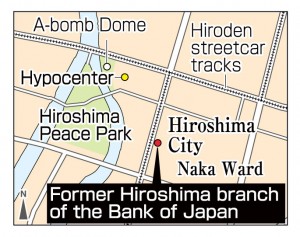Hiroshima: 70 Years After the A-bombing: Close-range Survivors 3
Jul. 30, 2014
Kazuko Fujishima, 69: Returns to building after 69 years
At Hiroshima branch of Bank of Japan at time of A-bombing
Chanced to be in basement: Escaped death
Kazuko Fujishima, 69, was at the Hiroshima branch of the Bank of Japan, about 380 meters southeast of the hypocenter, at the time of the atomic bombing. Only 5 months old, she was being carried on her mother’s back. Naturally, she has no recollection of the events of that day. In fact, during a recent visit to Hiroshima, she expressed surprise upon seeing that the 3-story ferroconcrete building that had housed the bank was still standing. In response to the paper’s request for an interview, Ms. Fujishima, now a resident of Kobe, went inside the building in Fukuro-machi, Naka Ward for the first time in 69 years.
In the second-floor museum she reviewed the events of August 6, 1945, which she too experienced. The room’s wooden walls bear marks where they were pierced by shards of glass as a result of the blast. Ms. Fujishima closely examined photos of the ruins of the city’s downtown area and of the interior of the building’s third floor, which was gutted because the shutters on its windows were open. “The destruction was much worse than I thought,” she said, looking pensive. Twelve people died in the offices of the Hiroshima Regional Finance Bureau, which was located on the third floor, along with eight Bank of Japan employees.
From the second floor Ms. Fujishima proceeded to the basement, where the vault was located and where she was carried on the back of her mother, Kiku Tomioka, then 32. She recalled what she had heard from her mother about the events of August 6. “If she hadn’t gone down to the basement, I wouldn’t be here,” Ms. Fujishima said.
Sisters never found
That morning, Kiku left their home in Tera-machi (now part of Naka Ward) and headed to the bank to cash in a war bond, carrying Kazuko on her back. As she waited outside for the bank to open, a woman who worked in the cafeteria urged Kiku to come in out of the heat and escorted her to the cool basement. The mother and daughter escaped with only injuries to their shoulders and other areas from shards of glass.
About all Kiku told Ms. Fujishima was that right after the A-bombing she fled to Hijiyama. “She didn’t like to talk about it, and it was difficult for me to ask her about it,” Ms. Fujishima said. Her eldest sister, Sumiko, 7, was a student at Hirose National School. Kiku had left Hiroko, 4, with the neighbors before going out. Their remains were never found.
Ms. Fujishima’s father was a crewman aboard a ship that had been requisitioned by the military. After he returned, the family moved to Ujina-cho (now part of Minami Ward), and Ms. Fujishima’s brother was born. But from as far back as she can remember her mother’s health was frail. “She spent most of the day resting and seemed to feel guilty about it,” she said.
Plagued by headaches
From the time she was in elementary school, Ms. Fujishima did the grocery shopping and housework for her mother, but she was plagued by frequent headaches. The scars from the shards of glass were very noticeable when she wore short sleeves in summer. On numerous occasions a car from the Atomic Bomb Casualty Commission picked her up at Ujina Elementary School and took her for tests.
When she was 11 the family moved to Amagasaki in Hyogo Prefecture on account of her father’s job. She met Yasushi Fujishima, who would become her husband, while working at a nail manufacturing company after she graduated from high school. Her headaches continued into adulthood, and she sometimes had to cut short her dates with Yasushi. In letters to Kazuko, Yasushi expressed concern about her fear that her headaches were the result of the A-bombing. They married when she was 23.
She gave birth to a son and daughter, but not long after that, at the age of 31, she collapsed from a cerebral hemorrhage. Although she received treatment in the hospital for one month, she continued to experience numbness of the upper left side of her body and had to rest at home for a lengthy period.
In 1996 Kiku was diagnosed with skin cancer. One night Kazuko lay futons side by side at her home and slept beside her mother, holding her hand. When she woke up the next morning her mother was dead. It was Kiku’s 84th birthday.
The bank building in Fukuro-machi continued to be used for business purposes until 1992. In 2000 it was designated an important cultural property by the city. It is now used for exhibitions related to cultural activities of local citizens. Of the 78 remaining survivors (as of 1972) who miraculously escaped death despite being within 500 meters of the hypocenter, 22 had been at the bank branch.
“I don’t remember anything, so I don’t have much sense of being an A-bomb survivor,” Ms. Fujishima said. But she was filled with emotion after her first visit in 69 years to the site where her life after the A-bombing began.
“I think my mother was filled with regret and grief, wishing she’d taken my sisters with her to the bank too,” she said. Her husband died seven years ago. She’s now looking forward to a visit from her five grandchildren. She said she sincerely hopes they will visit Hiroshima someday.
(Originally published on June 16, 2014)









